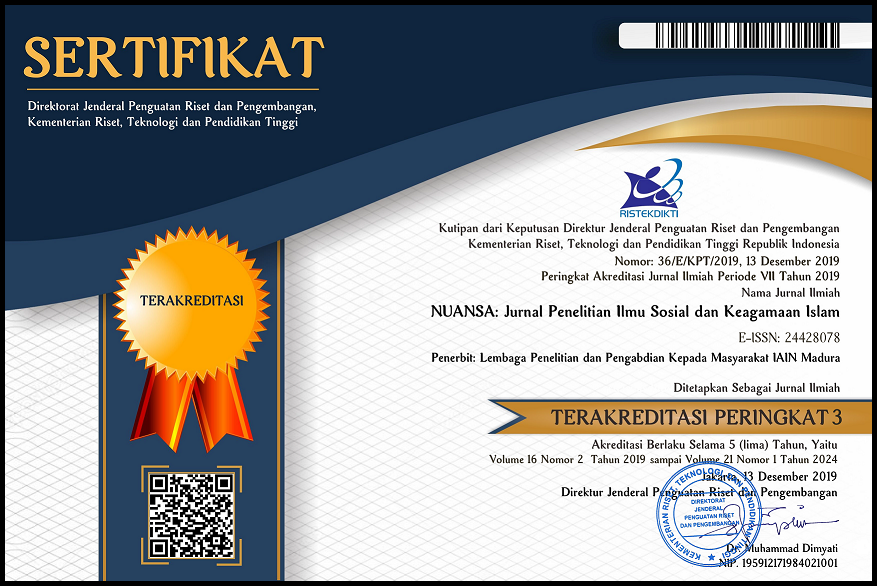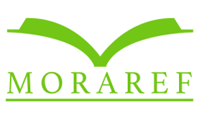Diversitas dan Dialog Lintas Agama: Konstruksi Wacana Perdamaian Pada Siswa Multi-Agama di Sidoarjo
 Abstract views: 399
,
Abstract views: 399
,
 pdf downloads: 266
pdf downloads: 266
Abstract
This article examines the use of children's language in religious dialogue in schools. Language is a means of communication and a means of forming one's understanding. Through language, they are able to respond to and explore various religious ideas of each other. This study uses the conceptual theory of dialogueism from Mikhail Bakhtin on the assimilation of language and meaning which is a feature of children's religious discourse construction. In addition, Martin and Bartlett's concept of positive discourse and Fairclough's lingual device were also used in this study. This research was conducted in one of the private elementary schools in Sidoarjo Regency. . The choice of location cannot be separated from the fact that the school has diverse students and teachers, both in terms of ethnicity, religion, economy, and background. Students at the school are synonymous with diversity. Observations and interviews were used for data collection in this article. The results showed that children's language got various concepts and language related to religion. They engage with narratives of various beliefs and position their own understanding of religion in confluence with the words and meanings they have assimilated from the encounters of each of these traditions. In addition, the various features of language that children show positive and diverse words, This article is important to review language for religious education from a broader understanding of children's religious dialogue.
(Artikel ini mengkaji penggunaan bahasa anak dalam dialog keagamaan di sekolah. Bahasa menjadi sarana komunikasi dan sarana membentuk pemahaman seseorang. Melalui bahasa, mereka mampu menanggapi dan mengeksplorasi berbagai ide agama masing-masing. Penelitian ini menggunakan teori konsepsi tentang dialogisme dari Mikhail Bakhtin pada asimilasi bahasa dan makna yang merupakan ciri konstruksi wacana keagamaan anak-anak. Selain itu, konsep wacana positif Martin dan Bartlett serta piranti lingual Fairclough turut digunakan dalam penelitian ini. Penelitian ini dilakukan di salah satu Sekolah Dasar Swasta yang ada di Kabupaten Sidoarjo. Pemilihan lokasi tidak terlepas bahwa sekolah tersebut memiliki siswa dan guru yang beragam, baik dari segi etnis, agama, ekonomi, dan latar belakang. Siswa di sekolah identik dengan keberagaman. Observasi dan wawancara digunakan untuk pengumpulan data pada artikel ini. Hasil penelitian menunjukkan bahwa bahasa anak-anak mendapatkan berbagai konsep dan bahasa terkait dengan agama. Mereka terlibat dengan narasi berbagai kepercayaan dan memposisikan pemahaman agama mereka sendiri dalam kaitannya dengan kata-kata dan makna yang telah mereka asimilasi dari pertemuan dengan masing-masing tradisi tersebut. Selain itu, berbagai fitur lingual yang diungkapkan oleh anak-anak menunjukkan kosa kata yang positif dan membangun keberagaman, Artikel ini penting untuk meninjau implikasi bahasa bagi pendidikan agama dari pemahaman yang lebih luas tentang proses membangun makna dalam dialog keagamaan anak.)
Downloads
References
Al-Khazaali, Musaab, and Researcher Shameem Al-salami. “Modal Interaction in Interfaith Dialogue: A Semiotic Study.” Kufa Journal of Arts (Adab Al-Kufa) 42, no. 1 (2020): 11–16.
Allan, Keith. “Natural Language Semantics,” 2001.
Askarovich, Haydarov Anvar, and Ruziyeva Nafisa Zarifovna. “Semantics of Euphemism in Business Language.” Conferencious Online, 2021, 19–22.
Badan Pusat Statistik. “Kewarganegaraan Suku Bangsa Agama Dan Bahasa Sehari-Hari Penduduk,” 2012.
Bakhtine, Mikhaïl Mikhaïlovitch, and M M Bakhtin. The Dialogic Imagination: Four Essays. Austin: University of Texas Press, 1981.
Bartlett, Tom. “Positive Discourse Analysis.” The Routledge Handbook of Critical Discourse Studies, no. November 2019 (2017): 133–47. https://doi.org/10.4324/9781315739342.
Burridge, Kate. “Euphemism and Language Change: The Sixth and Seventh Ages.” Lexis. Journal in English Lexicology, no. 7 (2012).
Creswell, J. W., and J. D. Creswell. Research Design: Qualitative, Quantitative, and Mixed Methods Approaches. New York: Sage publications, 2017.
CNN Indonesia. Intoleransi Beragama di Jatim & Jabar Diklaim Naik 2019-2020. CNN Indonesia. (2021) Retrieved from https://www.cnnindonesia.com/nasional/20211004181458-20- 703252/intoleransiberagama-di-jatim-jabar-diklaim-naik-2019-2020.
Demirci, K. “On the Concept of Covering (Euphemism).” Milli Folklor 77 (2008): 21–34.
Derrida, Jacques. “Hostipitality.” Angelaki: Journal of Theoretical Humanities 5, no. 3 (2000): 3–18.
Fairclough, N. Critical Discourse Analysis: The Critical Study of Language. New York: Routledge, 2013.
Fairclough, Norman. Analysing Discourse: Textual Analysis for Social Research. London: Routledge , 2003.
Fosnacht, Kevin dan Cynthia Broderick. “Religious Intolerance on Campus: A Multi-Institution Study,” Journal of College and Character, 21(4), (2020):244–262.
Halsall, Anna, and Bert Roebben. “Intercultural and Interfaith Dialogue through Education.” Religious Education 101, no. 4 (2006): 443–52.
Harjatanaya, Tracey Yani, and Chang Yau Hoon. “Politics of Multicultural Education in Post-Suharto Indonesia: A Study of the Chinese Minority.” Compare: A Journal of Comparative and International Education 50, no. 1 (January 2018): 18–35. https://doi.org/10.1080/03057925.2018.1493573.
Hisyam, Muhamad. “Tinjauan Buku Islam Indonesia dan Utopia Negara Sekuler.” Masyarakat Indonesia 38, no. 2 (2017): 459–76.
Hoon, Chang-Yau. “Multicultural Citizenship Education in Indonesia: The Case of a Chinese Christian School.” Journal of Southeast Asian Studies 44, no. 3 (2013): 490–510.
Hudson, Tara D., Alyssa N. Rockenbach, Matthew J. Mayhew, and Lini Zhang. “Examining the RelationshipBetween College Students ’ Interworldview Friendships and Pluralism Orientation.” Teachers College Record 123(7), (2021): 1–36.
Ibrahim, Rustam. “Pendidikan Multikultural: Pengertian, Prinsip, dan Relevansinya Dengan Tujuan Pendidikan Islam.” ADDIN 7, no. 1 (November 2015). https://doi.org/10.21043/addin.v7i1.573.
Jameson, Julia. “The Interfaith Movement: The Words, The Truths, and the Ways,” 2013.
Jamillah, Sitti. “Examining Teaching Materials in Higher Education against Religious Intolerance and Pluralism in the Global Era: Islamic Perspective.” Dinamika Ilmu v21 n2 (2021):477-489.
Kambo, Gustiana dan Andi Ahmad Yani. “Political Identity and Religious Prejudice in a PostConflict Society: A Case Study of Poso, Indonesia.” Journal of Southwest Jiaotong University 56(3), (2021): 26–36.
Keraf, Gorys. “Diksi Dan Gaya Bahasa (Edisi Yang Diperbarui).” Jakarta: Gramedia Pustaka Utama, 2007.
Latif, Muhaemin, and Erwin Hafid. “Multicultural Attitudes in an Islamic Boarding School of South Sulawesi – Indonesia.” Cogent Education 8, no. 1 (2021). https://doi.org/10.1080/2331186X.2021.1968736.
Listia, Laode Arham, and Lian Gogali. Problematika Pendidikan Agama Di Sekolah. Yogyakarta: Interfidei, 2007.
Martin, J. R. “Positive Discourse Analysis: Solidarity and Change.” Revista Canaria de Estudios Ingleses 49, no. 1 (2004): 179–202.
Mietzner, Marcus dan Burhanuddin Muhtadi. “Explaining the 2016 Islamist Mobilisation in Indonesia: Religious Intolerance, Militant Groups and the Politics of Accommodation.” Asian Studies Review v42 n3 (2018): 479-497.
Mocanu, Mihaela. “Taboo and Euphemism in the Religious Language.” International Letters of Social and Humanistic Sciences 75 (2017): 1–9.
Muhid, Abdul. “Religious tolerance among college students: How it’s influenced by religious orientation and personality traits?” HUMANITAS: Indonesian Psychological Journal, 17(1), (2020):55.
Napier, Jonathan. “Interfaith Dialogue Theory and Native/Non-Native Relations.” Illumine: A Journal of the Centre for Studies in Religion and Society 10, no. 1 (2011): 77–90.
Parker, Lyn. “Religious Tolerance and Inter-Faith Education in Indonesia.” In Crises and Opportunities: Proceedings of the 18th Biennial Conference of the ASAA. Adelaide, 2010.
Raihani. “A Whole-School Approach: A Proposal for Education for Tolerance in Indonesia:” Theory and Research in Education 9, no. 1 (March 2011): 23–39. https://doi.org/10.1177/1477878510394806.
Raihani, R. “Education for Multicultural Citizens in Indonesia: Policies and Practices.” Compare: A Journal of Comparative and International Education 48, no. 6 (2018): 992–1009.
Santoso, A. Studi Bahasa Kritis: Menguak Bahasa Membongkar Kuasa. Bandung: Mandar Maju, 2012.
Sebastian, Leonard C. dan Alexander R. Arifianto. “TRaNS special section on Growing Religious Intolerance in Indonesia.,” TRaNS: Trans-Regional and National Studies of Southeast Asia 8(1), (2020) 1–5.
Schäffne, Christina, and Anita L Wenden. Language & Peace. Vol. 6. Routledge, 2005.
Smits, Tom F.H., and Paul Janssenswillen. “Multicultural Teacher Education: A Cross-Case Exploration of Pre-Service Language Teachers’ Approach to Ethnic Diversity.” International Journal of Qualitative Studies in Education 33, no. 4 (April 2019): 421–45. https://doi.org/10.1080/09518398.2019.1681536.
Tilaar, Henry Alexis Rudolf. Manifesto Pendidikan Nasional: Tinjauan dari Perspektif Postmodernisme dan Studi Kultural. Jakarta: Kompas, 2005.
Wales, R. (2022). Pendidikan Multikultural di Indonesia. Nusantara: Jurnal Pendidikan, Seni, Sains dan Sosial Humaniora, 1(01).
Wertsch, James V. Vygotsky and the Social Formation of Mind. Harvard University Press, 1985.
Copyright (c) 2023 NUANSA: Jurnal Penelitian Ilmu Sosial dan Keagamaan Islam

This work is licensed under a Creative Commons Attribution-NonCommercial 4.0 International License.
The journal operates an Open Access policy under a Creative Commons Attribution-NonCommercial 4.0 International License (CC-BY-NC) 
Authors who publish with this journal agree to the following terms:
- Authors retain copyright and grant the journal right of first publication with the work simultaneously licensed under a Creative Commons Attribution License that allows others to share the work with an acknowledgement of the work's authorship and initial publication in this journal.
- Authors are able to enter into separate, additional contractual arrangements for the non-exclusive distribution of the journal's published version of the work (e.g., post it to an institutional repository or publish it in a book), with an acknowledgement of its initial publication in this journal.
- Authors are permitted and encouraged to post their work online (e.g., in institutional repositories or on their website) prior to and during the submission process, as it can lead to productive exchanges, as well as earlier and greater citation of published work.





















